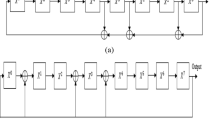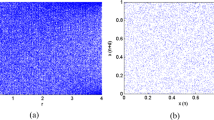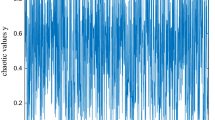Abstract
Recently, compressive sensing-based encryption methods which combine sampling, compression and encryption together have been proposed. However, since the quantized measurement data obtained from linear dimension reduction projection directly serve as the encrypted image, the existing compressive sensing-based encryption methods fail to resist against the chosen-plaintext attack. To enhance the security, a block cipher structure consisting of scrambling, mixing, S-box and chaotic lattice XOR is designed to further encrypt the quantized measurement data. In particular, the proposed method works efficiently in the parallel computing environment. Moreover, a communication unit exchanges data among the multiple processors without collision. This collision-free property is equivalent to optimal diffusion. The experimental results demonstrate that the proposed encryption method not only achieves the remarkable confusion, diffusion and sensitivity but also outperforms the existing parallel image encryption methods with respect to the compressibility and the encryption speed.









Similar content being viewed by others
Notes
Liao et al. [15] claimed that the full diffusion could be achieved even after the first round of encryption. However, their experiment in diffusion performance evaluation was not impartial. If one changes the original image pixel in the second quadrant, at least three rounds of encryption were necessary. Therefore, the property that full diffusion could be achieved after the first round encryption was just a best case. It should be bear in mind that when evaluating the security, only the worst boundary can be taken as a result.
The necessary round is defined as the minimum round to achieve the full confusion and diffusion.
Definition of unit throughput. Assume that the workload allocated to a processor is w, and the processing capacity of this processor is c. The unit throughput is defined as w/c.
Here, (m, n) is the coordinate of a quantized measurement within a block, while coordinate printed in the bold font (m, n) stands for the position of a block.
References
Babadi B, Kalouptsidis N, Tarokh V (2010) SPARLS: the sparse RLS algorithm. IEEE Trans Signal Process 58(8):4013–4025
Baraniuk RG (2007) Compressive sensing. IEEE Signal Process Mag 24(4):118–121
Bioucas J, Figueiredo M (2007) A New TwIST: two-step iterative shrinkage thresholding algortihms for image restoration. IEEE Trans Image Process 16(12):2992–3004
Blumensath T, Davies ME (2008) Gradient pursuits. IEEE Trans Signal Process 56(6):2370–2382
Candès EJ, Tao T (2005) Decoding by linear programming. IEEE Trans Inf Theory 51(12):4203–4215
Candès EJ, Romberg J, Tao T (2006) Robust uncertainty principles: exact signal reconstruction from highly incomplete frequecny information. IEEE Trans Inf Theory 52(2):489–509
Donoho DL (2006) Compressive sensing. IEEE Trans Inf Theory 52(4):1289–1306
Fei P, Qiu SS, Min L (2005) An Image Encryption Algorithm based on Mixed Chaotic Dynamic Systems and External Keys. In IEEE Internation Conference Communic Circuits & Systems, pp: 1135–1139
Gan L (2007) Block Compressed Sensing of Natural Images. In 15th International Conference on Digital Signal Processing, pp: 403–406
Gang C, Yu ZX (2005) A self-adaptive algorithm on image encryption. J Softw 119(11):1974–1982
Gao DH, Liu DH, Feng YQ Yu FP (2010) A Robust Image Transmission Scheme for Wireless Channels Based on Compressive Sensing. In ICIC′10 Proceedings of the Advanced intelligent computing theories and applications, pp: 334–341
Gorodnitsky IF, Rao BD (1997) Sparse signal reconstruction from limited data using FOCUSS: a re-weighted norm minmization algorithm. IEEE Trans Signal Process 45(3):600–616
Grangetto M, Magli E, Olmo G (2006) Multimedia selective encryption by means of randomized arithmetic coding. IEEE Trans Multimed 8(5):905–917
Lian SG (2008) Multimedia content encryption. CRC Press, Boca Raton
Liao XF, Lai SY, Zhou Q (2010) A novel image encryption algorithm based on self-adaptive wave transmission. Signal Process 90:2714–2722
Liu DH, Shi GM, Gao DH, Gao M (2009) A Robust Image Encryption Scheme over Wireless Channels. In International Conference on Wireless Communications & Signal Processing, pp: 1–6
Lloyd S (1982) Least squares quantization in PCM. IEEE Trans Inf Theory 28(2):129–137
Lustig M, Donoho DL, Santos JM, Pauly JM (2008) Compressed sensing MRI. IEEE Trans Signal Process 25(2):72–82
Mastan JMK, Sathishkumar GA, Bagan KB (2011) A color image encryption technique based on a substitution-permutation network. Adv Comput Commun 193(5):524–533
Mirzaei O, Yaghoobi M, Irani H (2011) A New image encryption method: parallel Sub-image encryption with hyper chaos. Nonlinear Dyn. doi:10.1007/s11071-011-0006-6
Mollin RA (2006) An introduction to cryptography. CRC Press, Boca Raton
Olshausen BA, Field DJ (1997) Sparse coding with an overcomplete basis Set: a strategy employed by V1. Vis Res 37(23):3311–3325
Orsdemir A, Altun HO, Sharma G, Bocko MF (2008) On the Security and Robustness of Encryption via Compressed Sensing. In IEEE Military Communications Conference, pp: 1–7
Rachlin Y, Baron D (2008) The Secrecy of Compressed Sensing Measurements. In 46th Annual Allerton Conference on Communication, Control and Computing, September, pp: 813–817
Shtewi AA, Hasan BEM, Hegazy AEF (2010) An efficient modified advanced encryption standard (MAES) adapted for image cryptosystems. Int J Comput Sci Netw Secur 10(2):226–232
Tropp JA, Gilbert AC (2007) Signal recovery from random measurements via orthogonal matching pursuit. IEEE Trans Inf Theory 53(12):4655–4666
Vanstone SA, Menezes AJ, Oorschot PC (1999) Handbook of applied cryptography. CRC Press, Boca Raton
Wang S, Kuang J, Li J (2002) Chaos-based communication in a large community. Phys Rev 66(6):1–4
Wu CP, Kuo CCJ (2000) Fast Encryption Methods for Audiovisual Data Confidentiality. In Proceedings of SPIE, pp: 284–295
Wu Y, Noonan JP, Agaian S (2011) NPCR and UACI randomness tests for image encryption. Cyber J: Multidiscip J Sci Technol: J Sel Areas Telecommun 2(4):31–38
Zhou K, Wong X, Liao F et al (2008) Parallel image encryption algorithm based on discretized chaotic Map. Chaos, Solitons Fractals 38:1081–1092
Zhou Q, Hu Y, Liao XF (2010) Analysis of the diffusion property of image encryption algorithm in block-and-permutation mode and its implementation. J Electron Inf Technol (Chin) 32(8):2015–2018
Acknowledgment
The second author acknowledges the support provided by Grant NRF-2011-013-D00121 from the National Research Foundation of Korea.
Author information
Authors and Affiliations
Corresponding author
Rights and permissions
About this article
Cite this article
Huang, R., Rhee, K.H. & Uchida, S. A parallel image encryption method based on compressive sensing. Multimed Tools Appl 72, 71–93 (2014). https://doi.org/10.1007/s11042-012-1337-0
Published:
Issue Date:
DOI: https://doi.org/10.1007/s11042-012-1337-0




